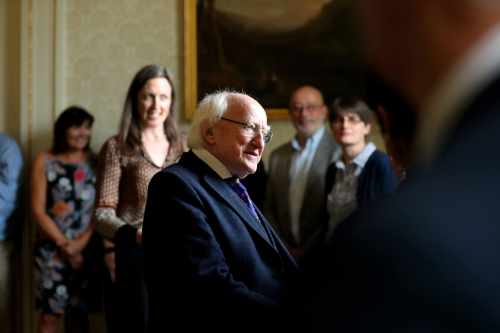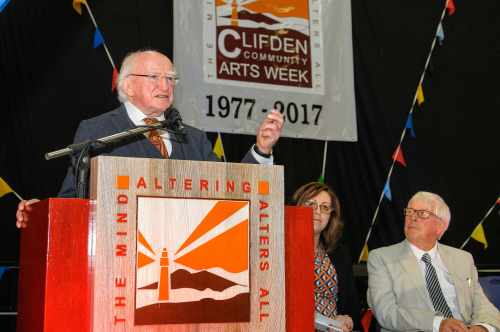Speech at the 20th Anniversary of the Opening of The National Museum of Ireland Collins Barracks
Collins Barracks, Dublin, 12 September 2017
Tá áthas orm a bheith anseo libh ar fad inniu agus sinn ag ceiliúradh 20 bliain ó osclaíodh Brainse na hEalaíona Maisiúla agus Stair Ard-Mhúsaem na hÉireann anseo i nDún Uí Choileáin.
[I am delighted to be here with you all today as we celebrate the 20th Anniversary of the opening of the Decorative Arts and History Branch of the National Museum of Ireland here at Collins Barracks.]
It was during my time as Minister for Arts, Culture and the Gaeltacht, that Collins’ Barracks was first secured as the site for this important branch of the Museum. The decision to cancel the sale of the Barracks and pursue its public use as a heritage location was taken by me but would not have been possible without the interest, initiative and co-operation of my valued Cabinet colleague David Andrews, the Minister for Defence. It was an important moment in Ireland’s cultural history, a moment that was to bear much fruit and as the National Museum at Collins’ Barracks celebrates its 20th anniversary this Museum has much to look back on with great pride and satisfaction.
May I commence by saying what a great pleasure it always is to come to Collins’ Barracks. The Barracks constitutes a space rich in history which has witnessed, and indeed played its own seismic role, in so many significant chapters of Ireland’s complex past.
Stretching back three centuries and beginning its life as the Royal Barracks, Collins’ Barracks was erected in an Ireland under British rule as part of a network of barracks connecting the 6 main Irish Garrisons. Across the intervening centuries, the Barracks has been at the centre of many important historical moments.
It was here that Wolfe Tone was court martialled and imprisoned following the 1798 Rebellion against British rule. It was from here that two hundred and twenty soldiers marched to their death in Gallipoli during the first World War, and, of course, it was here that rebellion troops tackled rebel positions on Usher's Island, at the Four Courts, and in the GPO during the 1916 Easter Rising. Today the Barracks is named after Michael Collins, the first Commander-in-Chief of the Irish Free State Army, while the main quadrangle is named after Thomas Clarke, one of the executed rebel leaders, and the Barracks has become synonymous, in many Irish minds, with our long and bitter struggle for independence.
Collins Barracks is now not only, however, a place with its own profound history. It is also, since the end of the 1990s, a custodian of our rich heritage, a place where an invaluable strand of that heritage is safeguarded and, very importantly, made available to all citizens. As the location for the Decorative Arts and History branch of the museum, Collins Barracks stands at the forefront of Ireland’s cultural life, conserving and displaying many beautiful works that connect us, in a profound way, to our past and the many significant, and indeed quiet moments that have influenced and formed the Ireland we inhabit today.
Artistic works not only reflect the society and time in which they were created; they also, in the here and now, help to shape and shade the world in which we live while also challenging us to look at that world in different ways. Spaces like the one we celebrate today are important, indeed critical to a truly functioning society, holding so much of our collective memory within their walls.
Mar sin is mór an phléisiúir dom an deis seo a ghlacadh le haitheantas a thabhairt don tábhacht a bhaineann le Brainse na hEalaíona Maisiúla agus Stair Ard-Mhúsaem na hÉireann, agus don méid a chuireann sé le cultúr ár sochaí.
[It is a great pleasure therefore to have this opportunity to acknowledge the importance of the Decorative Arts and History Branch of the National Museum, and all that it contributes to the cultural dimension of our society.]
I understand that the Museum now holds over half a million objects in its Decorative Arts and History collection and currently hosts twenty one separate exhibitions. They are exhibitions whose range and breadth gift us with unique insights into so much human thought and experience, telling us what has gone before, and looking to the future in ways that are inspiring and full of possibility.
Earlier this year I had the pleasure of coming here to open Portrait of a Century, a photographic celebration of the diversity of our people and the range of their contributions across a century of Irish life. These images constitute a powerful evocation of the bounty of ideas, achievements, vulnerabilities, and commitments of an intellectual, political, artistic or sporting kind, that have shaped our collective destiny throughout ten decades.
Today, I have yet again been fortunate to witness how the combined powers of memory and imagination can contribute so profoundly to the ongoing evolution of our society. I was delighted to receive a most interesting tour of three of the current exhibitions located here in Collins’ Baracks; exhibitions which connect us, across time and distance, to some of the many powerful stories which have built a nation.
Seamus Heaney’s description of how inherited objects provide us with:
‘a point of entry into a common emotional ground of memory and belonging’
is apt.
I was reminded of those words again here this morning as I experienced four centuries of evolving Irish furniture design at the ‘Reconstructed Rooms’ Exhibition and witnessed three and a half decades of changing Irish fashion through a retrospective of the work of the renowned Ib Jorgenson. I very much recall Ib Jorgensen telling me in the 1990s that he wished fashion was part of the responsibilities of the Department I had created as the Department of Arts, Culture and the Gaeltacht. Each piece of craftsmanship, each designed object, on show or held here reflect lives lived and stories written in a past that has so profoundly influenced the Ireland we inhabit today. They are a reminder of the real debt of gratitude we owe to our designers, our artists, our craftsmen who allow us so many opportunities to not only engage with the past, but to witness its unfolding.
Art, of course, has always transcended cultural barriers speaking to, and of, a common humanity. In our increasingly interdependent world art and design has evolved, weaving new and vibrant patterns whilst allowing each strand to retain its own distinct identity.
The ‘Shadow of Sodeisha: Japanese and Irish Art in Clay’ exhibition is not only a fitting memorial to the founding of diplomatic ties between our two countries, but also a demonstration of how contemporary sculpture from two island nations at the extremities of Asia and Europe can speak to us of both unique and separate pasts and of a shared future of great possibility.
These, and the many other exhibitions housed here in Collins’ Barracks, invite us to deepen our knowledge and understanding of Irish political, military and social history, and are an invaluable record of the making of modern Ireland and its relationship with the outside world.
Before I conclude may I thank Catherine Heaney, Chair of the Museum, for her invitation to be here with you all this morning to mark the 20 year anniversary of the opening of this branch of the Museum. I also thank and congratulate all those who have worked, with such care and dedication, to ensure the ongoing success of the Decorative Arts and History Branch of the National Museum of Ireland here at Collins Barracks.
Our cultural heritage, in all its many forms, is at the very heart of our identity; connecting us not only to our shared past, but to our creative present and to a future full of possibilities. We are deeply grateful therefore to those who work to keep that culture and heritage alive and relevant in an Ireland that continues to evolve and change, and who also enable us to view our world in ways that are new and emancipatory.
Tá a fhios agam go bhfuil an Músaem ag tabhairt máistirphlean chun críche chun tuilleadh forbairtí a dhéanamh ar na láithreacha éagsúla atá faoi chúram an Mhúsaem agus guím gach rath ar an togra seo.
[I am aware that the Museum is currently in the process of finalising a Master plan for the further development of all four sites belonging to the Museum and I wish you every success with this.]
May I say how aware I am of what has been achieved, but more importantly what could be achieved if resources at Turlough House and the other sites secure additional, dare I say essential, increases in funding.
In conclusion, I congratulate you all on reaching this milestone and wish you every success as you continue with your important work.
Go raibh míle maith agaibh go léir.


